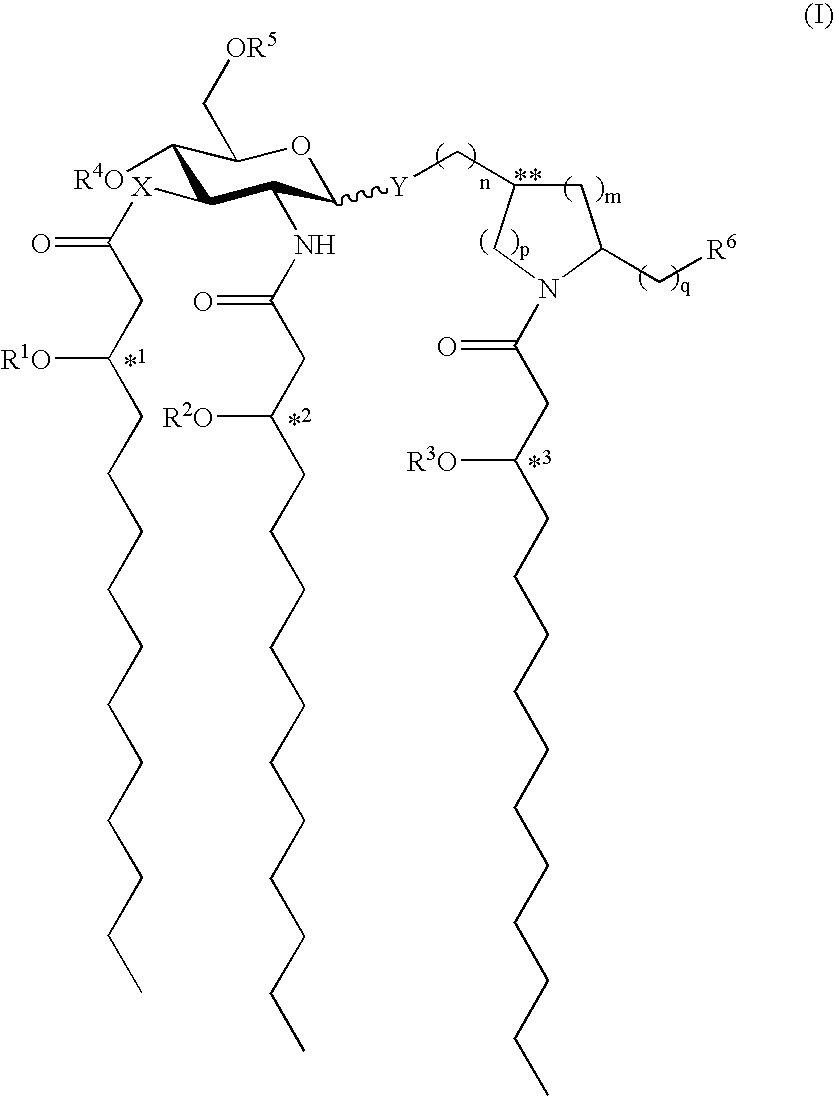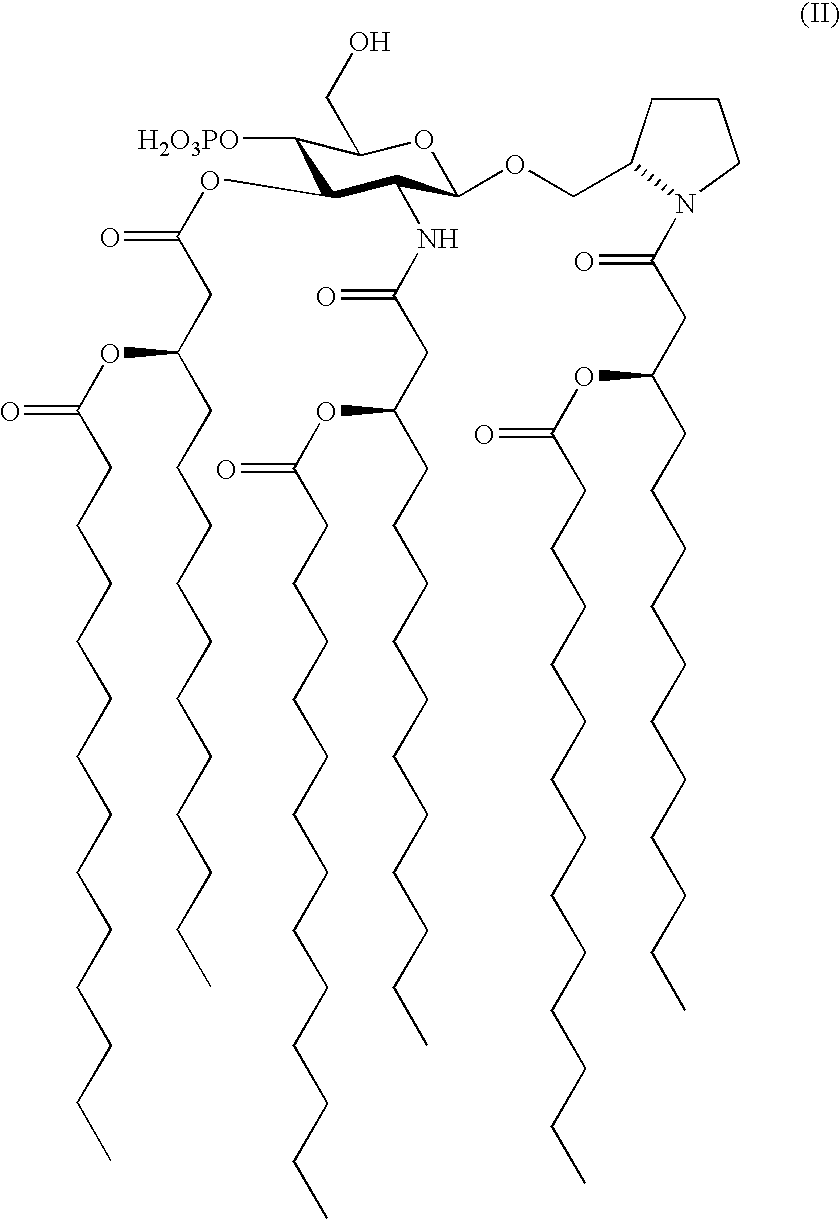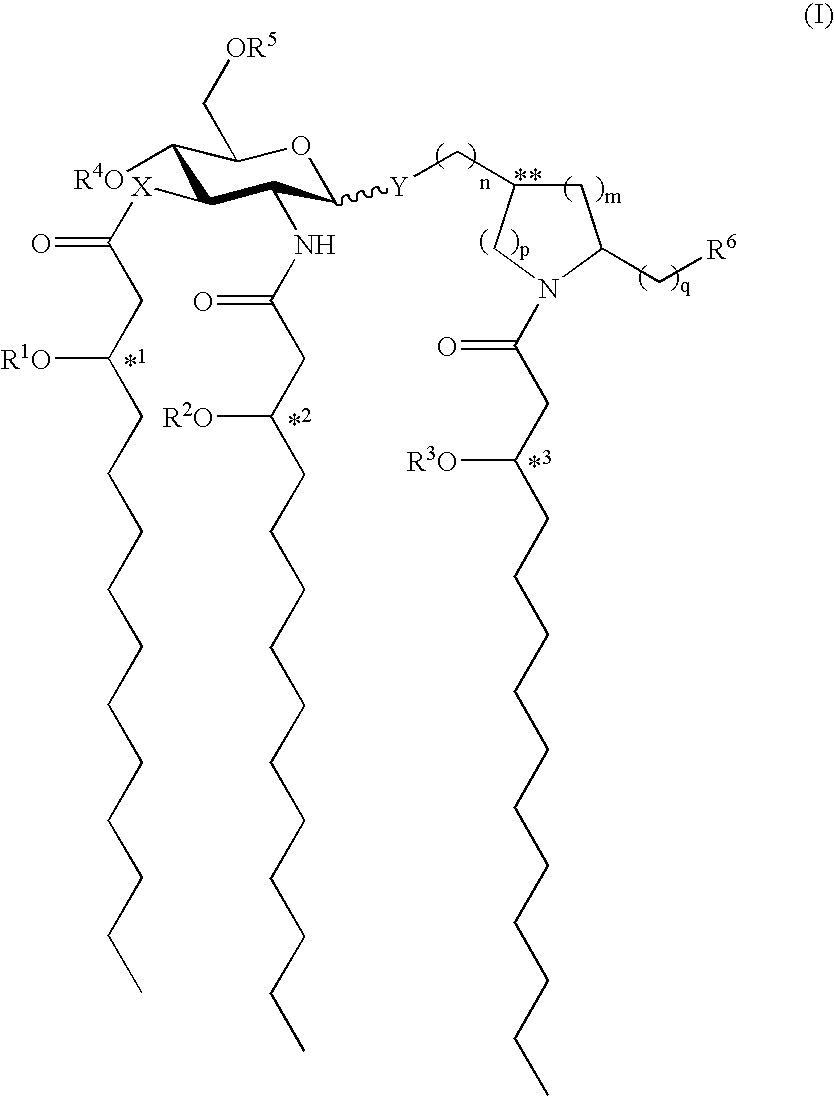Immunoeffector compounds
a technology of immunogenic effectors and compounds, applied in the field of adjuvant systems, can solve the problems of insufficient immunogenicity of prior adjuvant systems, concomitant loss of potency, and insufficient immunogenicity of synthetic antigens of low molecular weight,
- Summary
- Abstract
- Description
- Claims
- Application Information
AI Technical Summary
Benefits of technology
Problems solved by technology
Method used
Image
Examples
example 1
Preparation of RC-553
[0084]Preparation of N—[(R)-3-Tetradecanoyloxytetradecanoyl]-(S)-2-pyrrolidinomethyl 2-Deoxy4-O-phosphono-2-[(R)-3-tetradecanoyloxytetradecanoylamino]-3-O—[(R)-3-tetradecanoyloxytetradecanoyl]-β-D-glucopyranoside Triethylammonium Salt (formula (I), R1═R2═R3═C13H27CO, X═Y═O, n=1, m=2, p=q=0, R5═R6═H, R4═PO3H2; formula (II) R1═R2═R3═C13H27CO); RC-553.
[0085](1) To a solution of 2-deoxy-4-O-diphenylphosphono-3-O—[(R)-3-tetradecanoyloxytetradecanoyl]-6-O-(2,2,2-trichloro-1,1-dimethylethoxycarbonyl)-2-(2,2,2-trichloroethoxycarbonylamino)-β-D-glucopyranosyl bromide (1.05 g, 0.81 mmol) in dry 1,2-dichloroethane (10 mL) were added 4 Å molecular sieves (0.5 g), anhydrous CaSO4 (2.2 g, 16 mmol), and N—[(R)-3-tetradecanoyloxytetradecanoyl]-(S)-2-pyrrolidinomethanol (0.40 g, 0.75 mmol). The resulting mixture was stirred for 1 h at room temperature, treated with Hg(CN)2 (1.02 g, 4.05 mmol), and heated to reflux for 16 h in the dark. The cooled reaction mixture was diluted wit...
examples 2 – 6
Examples 2–6
[0089]The primary objective of Examples 2–6 was to determine if RC-553 could promote minimal pyrogenicity and mediate adjuvant activity when formulated with vaccine antigens.
example 2
Adjuvant Activity Towards HBsAg (Hepatitis B Surface Antigen)
[0090]Groups of BALB / c mice (Jackson Laboratories Bar Harbor, Me.) 6–8 weeks old were injected s.c. with 2 μg HBsAg (Laboratorio Pablo Cassara) ±20 μg adjuvant (MPL® immunostimulant or RC-553) on day 0 and day 21. Vaccines were prepared by mixing the adjuvant-containing TEoA (triethanolamine) formulations with recombinant HBsAg. Titers to HBsAg were determined by ELISA from pooled sera (5 mice / group) collected 21 days post-secondary vaccination (Table 1). The nonimmune controls were not vaccinated.
[0091]Serum titers from mice receiving RC-553 had anti-HBsAg responses significantly higher than control sera receiving antigen alone (Table 1). Especially noticeable was the increase in the titers for the IgG2a and IgG2b isotypes. These titers were equivalent to those expressed by control groups receiving MPL® immunostimulant.
[0092]
TABLE 1Comparison of Low Pyrogen Adjuvants with HBsAgPyrogen-Serum TitersGroupsicityaIgGIgG1IgG2aI...
PUM
| Property | Measurement | Unit |
|---|---|---|
| Fraction | aaaaa | aaaaa |
| Fraction | aaaaa | aaaaa |
| Density | aaaaa | aaaaa |
Abstract
Description
Claims
Application Information
 Login to View More
Login to View More - R&D
- Intellectual Property
- Life Sciences
- Materials
- Tech Scout
- Unparalleled Data Quality
- Higher Quality Content
- 60% Fewer Hallucinations
Browse by: Latest US Patents, China's latest patents, Technical Efficacy Thesaurus, Application Domain, Technology Topic, Popular Technical Reports.
© 2025 PatSnap. All rights reserved.Legal|Privacy policy|Modern Slavery Act Transparency Statement|Sitemap|About US| Contact US: help@patsnap.com



